
Steve Waterhouse
Raptor Persecution
The Persecution Problem
Derbyshire is a place many feel lucky to call home. Large expanses of countryside, moorlands and wetlands create wonderful habitats for many creatures and attract tens of million visitors annually.
Unfortunately, the Peak District National Park is considered a black hole for birds of prey with many going missing or suffering persecution.
Species such as the hen harrier and the peregrine are protected by the Wildlife and Countryside Act (1981), which states that it is illegal to kill, injure or take wild birds.
However, persecution of wild birds of prey is still prevalent across our county. Persecution, mainly by shooting, poisoning, and trapping them, is still a major problem for certain species of birds of prey including the peregrine, goshawk, and hen harrier in this county.
In 2020 the Peak District National Park had the second highest number of incidents of bird crime found countrywide in any National park [1].
Even with these protections awarded to our birds, enforcing the law seems to be an issue across the country as clear evidence is needed in order to prosecute offenders.
In 2017, there were 68 confirmed incidents of raptor persecution in the UK, but only four prosecutions came to court and only one conviction resulted [2].
[1] 776-0507-20-21_Birdcrime_appendices_2020_v5.pdf (s3.us-east-1.amazonaws.com)
[2] Raptor Persecution | Birds of Prey UK Birdcrime Report – The RSPB[
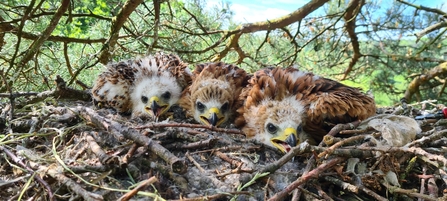
3 Red Kite Chicks June 22 (c) Ant Messenger
Nest Monitoring
This year (2022) , Derbyshire Wildlife Trust we were fortunate to receive funding from Swire Charitable Trust to help us start to combat this issue.
The funding has allowed us to employ a Peregrine Engagement Trainee who has worked hard to build a team of nest monitoring volunteers and will continue to raise awareness of bird of prey persecution.
Throughout the 2022 nesting season, we had over twenty volunteers monitoring a high risk peregrine site daily, allowing the successful fledging of two peregrine chicks.
We hope, with more fundraising, to build on the success of this pilot project over the coming years so that our birds of prey can be truly protected and can once again start to flourish in this county.
You too can get involved to help protect Derbyshire birds of prey, just look below to find out how.
How You Can Help
Derbyshire Cathedral Peregrines
Each spring you can watch the Derby Cathedral peregrines, hatch, grow and fledge. Get involved with watching these wonderful raptors and getting a peek into their early lives.
If you’d like the follow the stories of the 2022 Derbyshire peregrine falcons follow these links:
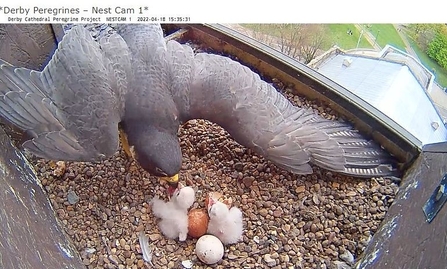
Peregrine falcon chicks - webcam screengrab by HelenSara
Hen Harrier Day
Hen Harrier Day was created to help celebrate these iconic birds and to raise awareness of the issues that they, and many other upland species, face. Sadly, our beautiful hen harrier is just one of the many species experiencing losses and, as with many birds of prey, the hen harrier struggles to thrive due to human persecution (poisoning, shooting, and trapping).
In 2020 & 2021 we ran our Hen Harrier Day themed anonymous art auctions. Professionals and amateurs, children, and adults all took part by creating and donating art for us to help raise awareness of the plight of the hen harrier and our uplands. In total, we received 190 pieces of art which raised a whopping £10,487 for wildlife.
For 2022 we have even more ways for you to get involved and help, this year we are teaming up with Writing East Midlands to run, not only an art auction but also a creative writing competition both focused on our fabulous UK birds.
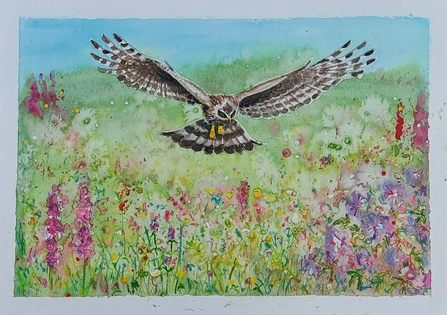
Sarah Hannis
www.sarahhannis.com twitter: @sarah_hannis facebook/instagram: @sarahhannisillustration
Volunteering & Donating
You can volunteer to help with peregrine watchpoints at the cathedral next year.
Your donations will also help us raise awareness and allow us to monitor raptor nests to try to prevent egg theft.
Some Species Under Threat
Use the drop down menus below to find to more about some of the problems these species face and what you can do to help.
Peregrine Falcon
Peregrine falcons disappeared from most of Derbyshire between 1955 and 1981, mainly due to the pesticide DDT. Chemicals such as DDT pass up the food chain and end up concentrated in ‘top predators’ such as raptors and otters.
Some animals are killed by these levels of pesticide while for others, if affects their breeding success [3]. Since DDT was banned, peregrine numbers have increased and the species is now stable and has a green conservation status.
The UK is home to 12-14% of the total European peregrine falcon population [4] and some peregrines have found sanctuary in our cities and towns. However, despite numbers being considered stable, the predicted rural population should actually be much higher. [6]
Peregrines still face persecution by being shot, trapped, poisoned, and also having their eggs (or more often their chicks) stolen. The Scottish Raptor Study Groups found that 22% of peregrine pairs didn’t fledge young within Southern and Eastern Scotland.[5]
In 2019 across the Dark Peak and South West Peak, peregrine pairs were found to occupy nine sites, however current studies suggest 17 pairs should be breeding in this area. Of the nine pairs found, only three had successfully fledged chicks and one site had clear evidence of nest tampering. [6]
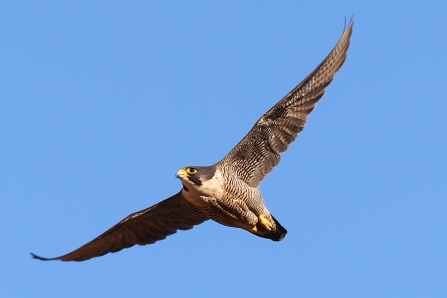
Peregrine, Dave Nay, via Flickr
Hen Harrier
Reduction in numbers of the hen harrier started to occur in the 1850s when records show they were routinely shot [7]. In 1900, heavy persecution of the hen harrier saw them come close to extinction in the UK. During and after the First World War, the species clawed itself back from the edge of extinction. However, since the turn of the millennium they have been struggling once more. Illegal killing and nest disturbance of the hen harrier is pushing this raptor, often called the ‘Ghost of the Moors’ close to extinction.
The UK population fell by 28% between 2004 and 2016 [8]. The hen harrier is now on the designated red list for birds with only 643 pairs found in 2010 declining to 545 pairs in 2017 [9].
In 2017, only three successful nests were found in the whole of England [10]. This species nests on the ground in open, upland moorlands such as the Dark Peak.
In 2022 two nests, with five eggs in each, were found abandoned due to both males ‘disappearing’ mysteriously [11]. The so-called ‘Ghost of the Moors’ truly will become a ghost if we cannot protect them more successfully.
Due to the continuing persecution of hen harriers on upland moors managed for intensive grouse shooting, an initiative was set up to fit young harriers with satellite tags, these tags placed on the hen harriers and give the locations of the birds.
A Natural England study produced a report that showed that some 72% of satellite tagged hen harriers were confirmed or considered to be illegally killed [12] [13]. It’s documented that at least 70 hen harriers have gone missing or been illegally killed since 2018 [14]
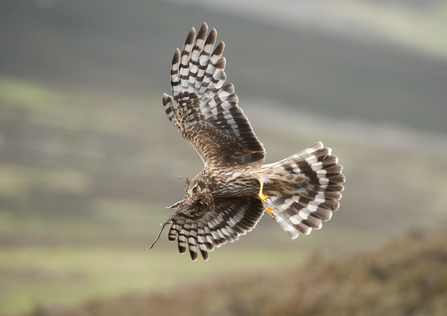
Merlin
Merlin
Our smallest bird of prey is the merlin. In the 1950s and 60s populations declined due to organochlorine pesticides with only 550 pairs left causing the species to be added to the red list [15].
Chemicals such as pesticides can pass up the food chain and end up concentrated in ‘top predators’ such as raptors and otters. Some animals are killed by these levels of pesticide while, for others, if affects their breeding success. While merlin numbers have increased since then, this species still continues to be the most contaminated species of raptor with heavy loads of mercury [15]. The merlin’s recovery has also been slowed by lack of suitable habitat, overgrazing and afforestation [15].
Merlins, like other raptors, still face some illegal killing on shooting estates and also persecution by egg collectors.
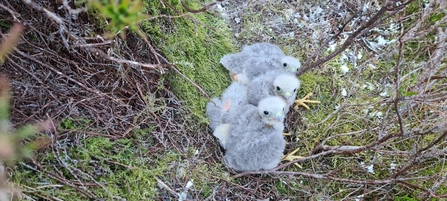
Merlin Chicks (c) Ant Messenger
Goshawk
Historically goshawks have been regularly persecuted in the British Isles. They stopped being a regular breeder in Britain early in the 1800s, with only 19 records of goshawks recorded between 1841 and 1888. From 1900-1965 there was little evidence of the goshawk regularly breeding in the UK. [17]
Reintroduction of the goshawk, mainly by falconers, occurred in the 1960s and 1970s and currently, there are 230-465 pairs in the UK.
Goshawks are on the green list and are specially protected by the Wildlife and Countryside Act (1981). [16] However they continue to be persecuted across their range and in the Dark Peak especially.
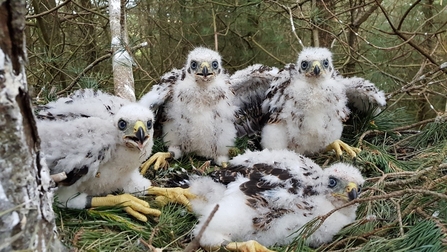
Goshawk Chicks (c) Ant Messenger
What is a bird of prey (raptor)?
A raptor or bird of prey is a bird that eats other animals and has a hooked beak and talons. Prime examples of raptors include eagles, falcons, hawks, kites, harriers and buzzards.
What is a listed bird species?
The listed species of bird was created by the British Trust for Ornithology and the Royal Society for the Protection of Birds (RSPB).
The list is split into four categories red, amber, green and black. [18]
- Species that no longer breed in the UK are found on the black list
- The red list is species that are threatened by global extinction, with breeding numbers having fallen by half and whose breeding range has reduced by at least 50%
- The amber list includes species which are threatened with European extinction. There has been a 25-50% decline in the breeding population and a 25-50% decline in the non-breeding population, or there are less than 900 individuals and less than 300 breeding pairs in the UK or they are found in less than 10 sites across the UK.
- Green is the bird which doesn’t show severe or moderate declines. However, despite having stable numbers birds can move quickly from the green list to the red list, a prime example of this is the greenfinch and ptarmigan both of which moved to the red list after a large decline in number.
[18] Endangered Birds | Red, Amber and Green Explained - The RSPB
